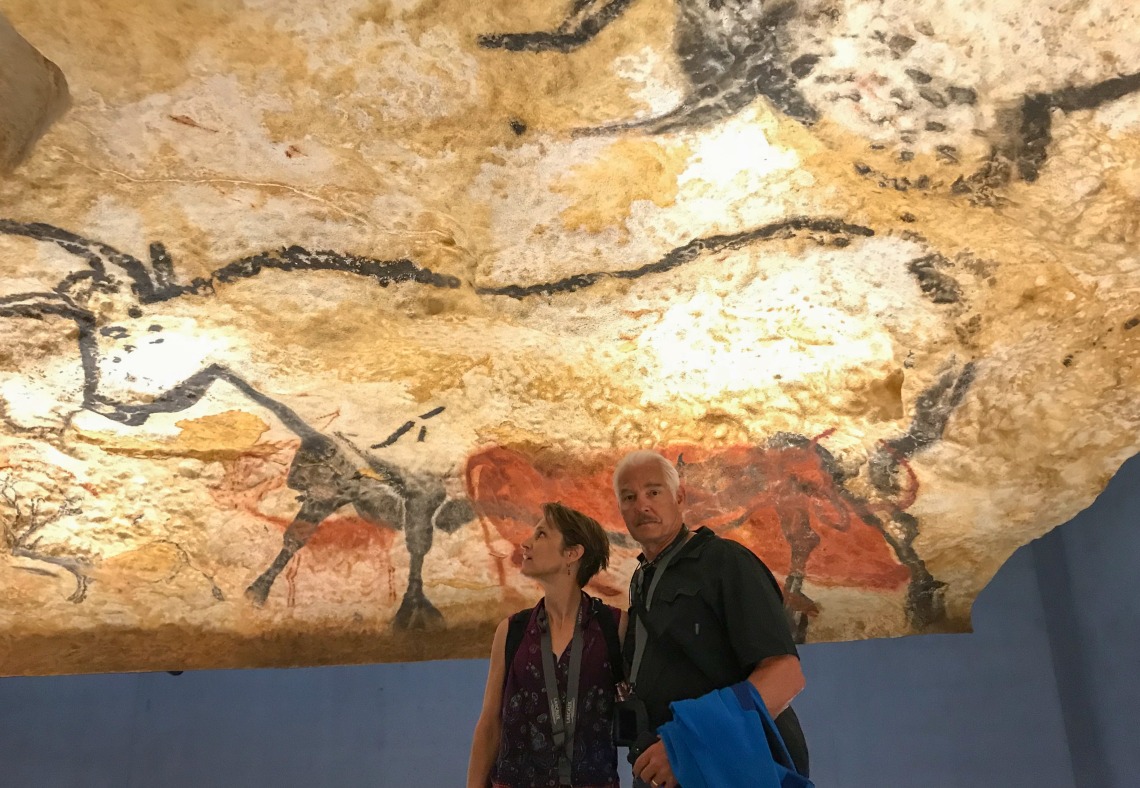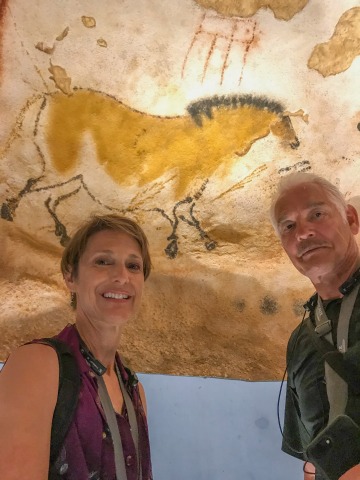Field Notes: Takeaways From Our Summer Studying Cows in Caves

Netzin (left) and Dieter Steklis stand in front of a cave painting of an aurochs in Lascaux, a cave complex in southern France. The aurochs, a prehistoric ancestor of the cow, is the only animal that prehistoric people painted life-size. (Photo courtesy of Dieter Steklis)

Prehistoric horses were also a favorite painting subject. (Photo by Netzin Steklis)
Dieter and Netzin Steklis, a husband-and-wife team of professors in the School of Animal and Comparative Biomedical Sciences, spent the summer studying prehistoric illustrations of animals inside caves in Europe. In this guest column, the couple, who are well-known for their research on gorillas, share their most interesting takeaways from the trip.
An important aspect of the field of animal sciences is an understanding of the long, temporal relationship between humans and other animals, both wild and domesticated.
Animals used for meat and milk production were domesticated by humans thousands of years ago, which changed their anatomy, physiology and behavior from their wild ancestors. But domestication would not have been possible if prehistoric peoples were not already skilled observers of the domesticates' wild ancestors. Many of these animals were hunted, with survival requiring intimate familiarity with animal behavior.
Fortunately, the earliest evidence of these remarkable observational skills and the profound importance of particular animals to prehistoric hunter-gatherers persists today in the form of European cave paintings and carved figurines.
After lecturing about this topic in our School of Animal and Comparative Biomedical Sciences classes for the past few years, we had the opportunity this summer to visit several of these prehistoric caves, dating from 40,000 to 15,000 B.P. (B.P. stands for "before present," with "present" defined as 1950). The 4,000-mile trip took us to nine cave sites in Germany, France and Spain, allowing us to experience firsthand the full range of this animal art and ponder its meaning.
We had seen images and other published materials on some of the best-known prehistoric caves, such as Lascaux in southern France and Altamira in northern Spain, but our visit nevertheless yielded several surprises. Here are five of them:
Artists Went Big When Painting Prehistoric Cows
Of all the animals decorating the cave walls at Lascaux (20,000 B.P.), only the aurochs – the prehistoric ancestor of modern cattle, including our milking cows – was painted life-sized in dramatic shades of red, brown and black. The prehistoric artists used the natural contours of the cave's interior and sophisticated shading techniques to give these aurochs three-dimensional shape, making their power and massive bulk all the more palpable. This powerful animal ignited our ancestors' imagination and likely had symbolic significance, perhaps like bulls stood for virility and strength in later Mediterranean civilizations.
The Artists Didn't Paint What They Ate
At several of the prehistoric sites, the bony archaeological evidence shows that the animals depicted in the art were not simply those most often hunted. For example, the aurochs, horse, and stag were the dominant painted animals, but the bony remains show that primarily reindeer were hunted. Again, this underscores the broader symbolic significance of the prehistoric animals that humans encountered.
Memory, Not Live Models, Used by Early Artists
At Altamira (36,000 B.P.), bison are the predominant theme, rendered in three-dimensional form by using the natural contours of the cave ceiling. Remarkably, too, the artists painted the bison in mixed-sex herds, with a large dominant male at the center, suggested by its massive musculature and elevated tail – all evidence of the artists' keen observational skills. We can be sure that no bison was led into the dark depths of the cave to then patiently pose for the artist! Rather, the bison, aurochs and indeed all of the large, dangerous animals decorating the caves' interior – cave lion, cave bear, mammoth – had to have been painted from the artists' superbly detailed visual memory built from years of observation and study. We can be sure, too, that the aurochs could not have been domesticated and transformed into a cow without this intimate knowledge of its ecology, morphology, temperament and habits. Justifiably, we should consider these prehistoric artists as the first ethologists – or early forerunners of Charles Darwin, Konrad Lorenz and Nikolaas Tinbergen.
Horses Were a Favorite Subject
Among the most stunning paintings in the caves are prehistoric horses – the wild stock that gave rise to the modern domesticated horse. They are painted in rich detail, often running in herds, and depicted with the short stubby manes more typical of zebras, donkeys, and the Przewalski's horse (the last remaining truly wild horse, native to central Asia), and with different coat colors and stripes, information we could never get from their preserved bones. The oldest artistic rendering of a horse – from about 40,000 B.P. – is a finely carved figurine from mammoth tusk found in the Vogelherd Cave in southern Germany. Thousands of years before horses were domesticated, they, too, were well-studied by our ice age ancestors.
People Were Never a Subject
Surprising also is the absence of paintings or drawings of people – of the hunters and artists themselves. The only unquestionable human image found in several caves consists of multiple handprints on the walls near the animal art – likely produced by blowing paint through a hollow bone over a hand placed on the wall to make a negative image. Perhaps they represent the artists' signature. It seems to us that the absence of human figures in the cave art suggests the artists' purpose was not to celebrate the prowess of human hunters but rather to symbolize the special significance other animals had in the lives of our ancestors.
There is so much more to show and tell from our summer's cave expedition. We are still in awe, pondering the art's significance, and excited to share our adventure. But it will have to wait until we return to our classes this fall.
Dieter Steklis and Netzin Steklis are professor of practice and assistant professor of practice, respectively, in the School of Animal and Comparative Biomedical Sciences, where they regularly co-teach a large general education class on human and animal interrelationships. The couple often collaborate with students on research projects under the HAIRI program (Human-Animal Interaction Research Initiative).

